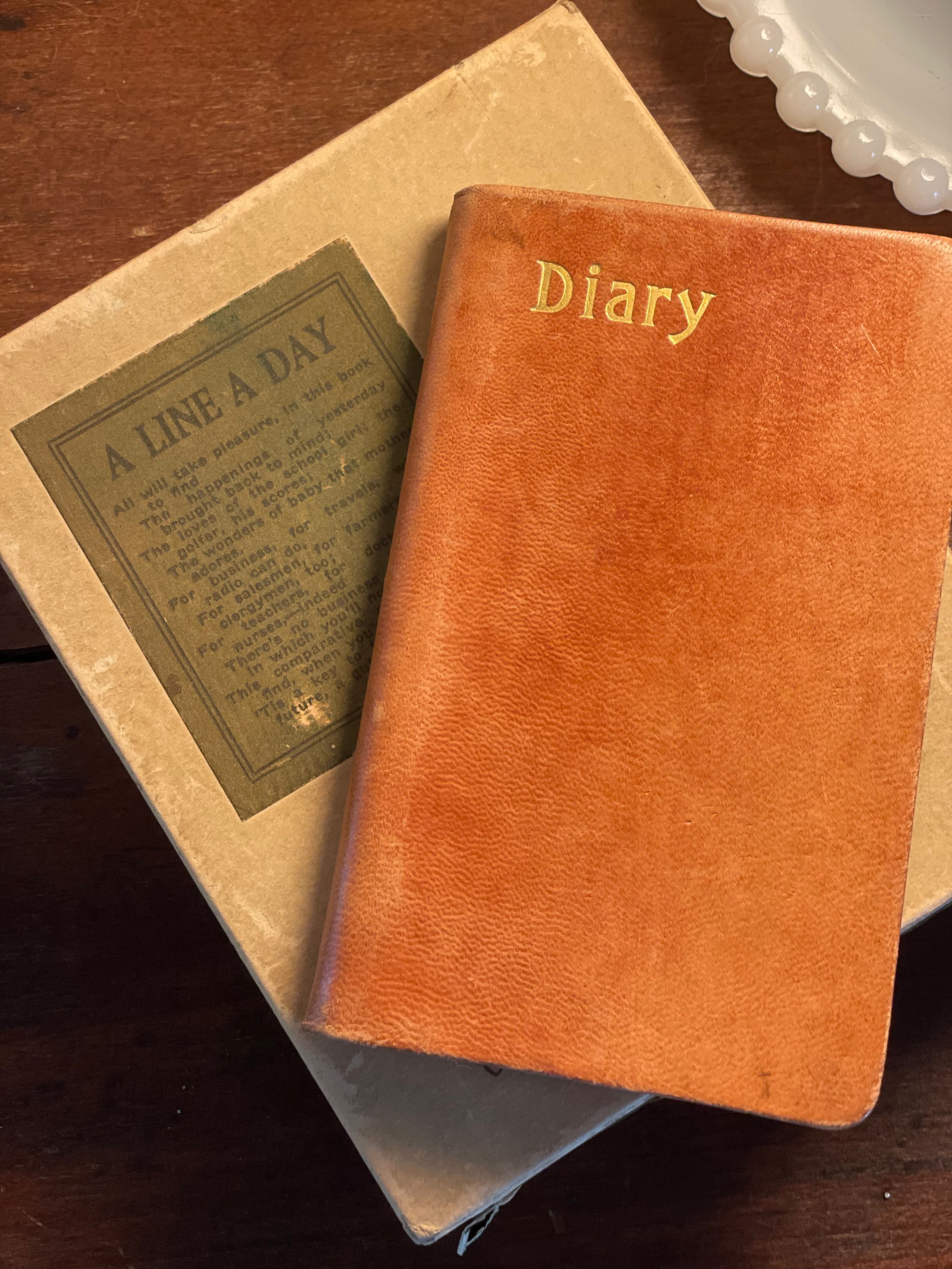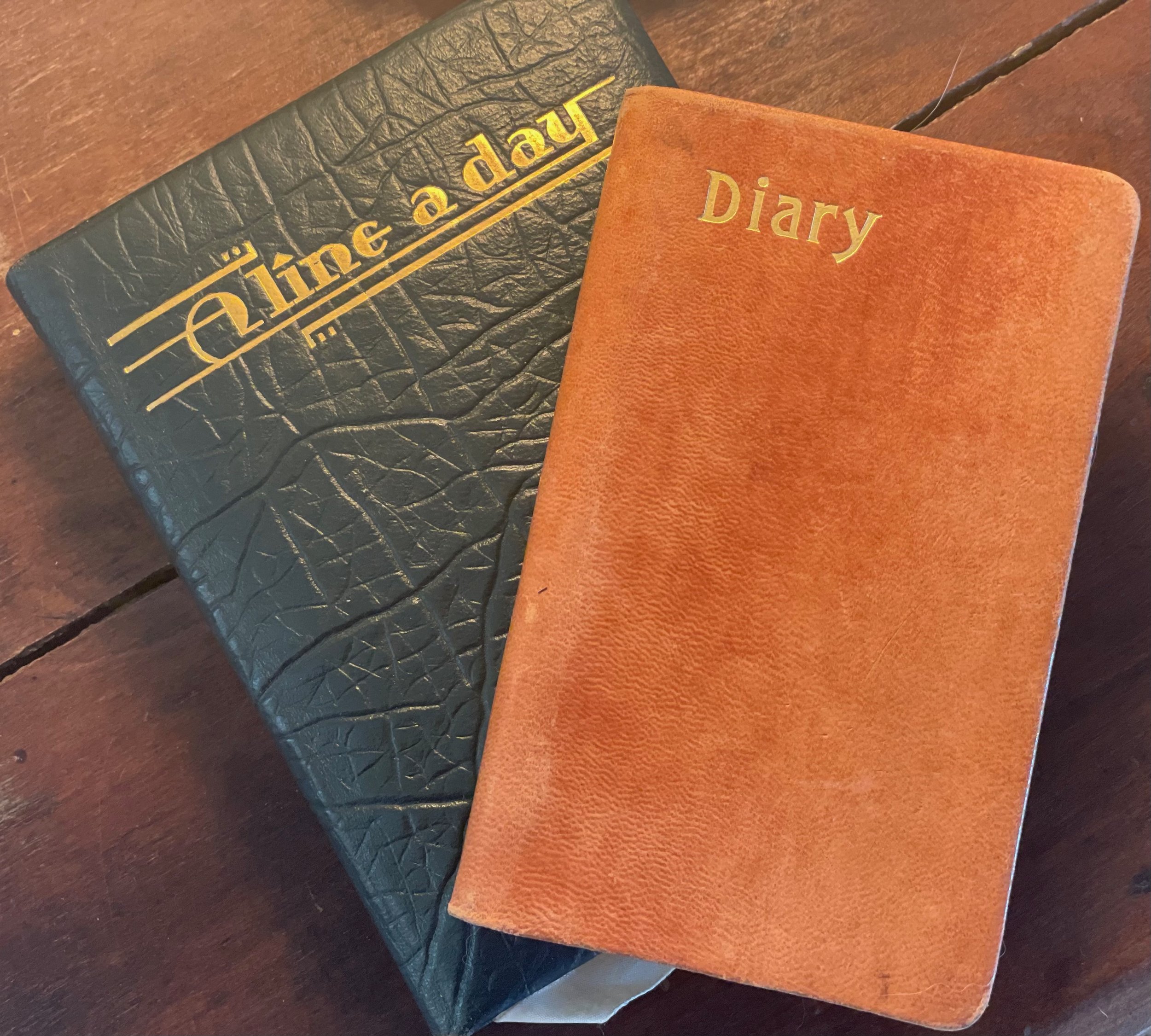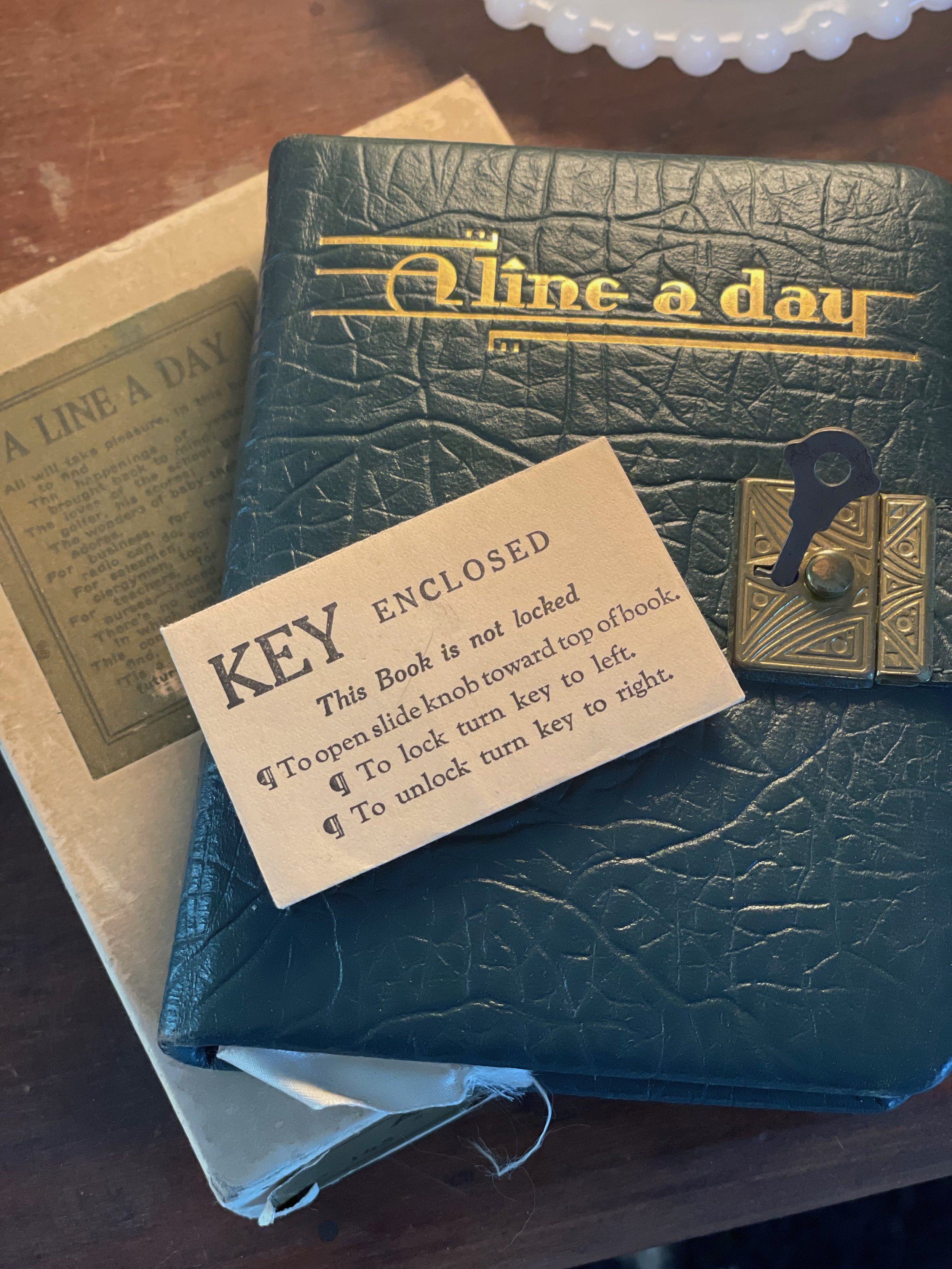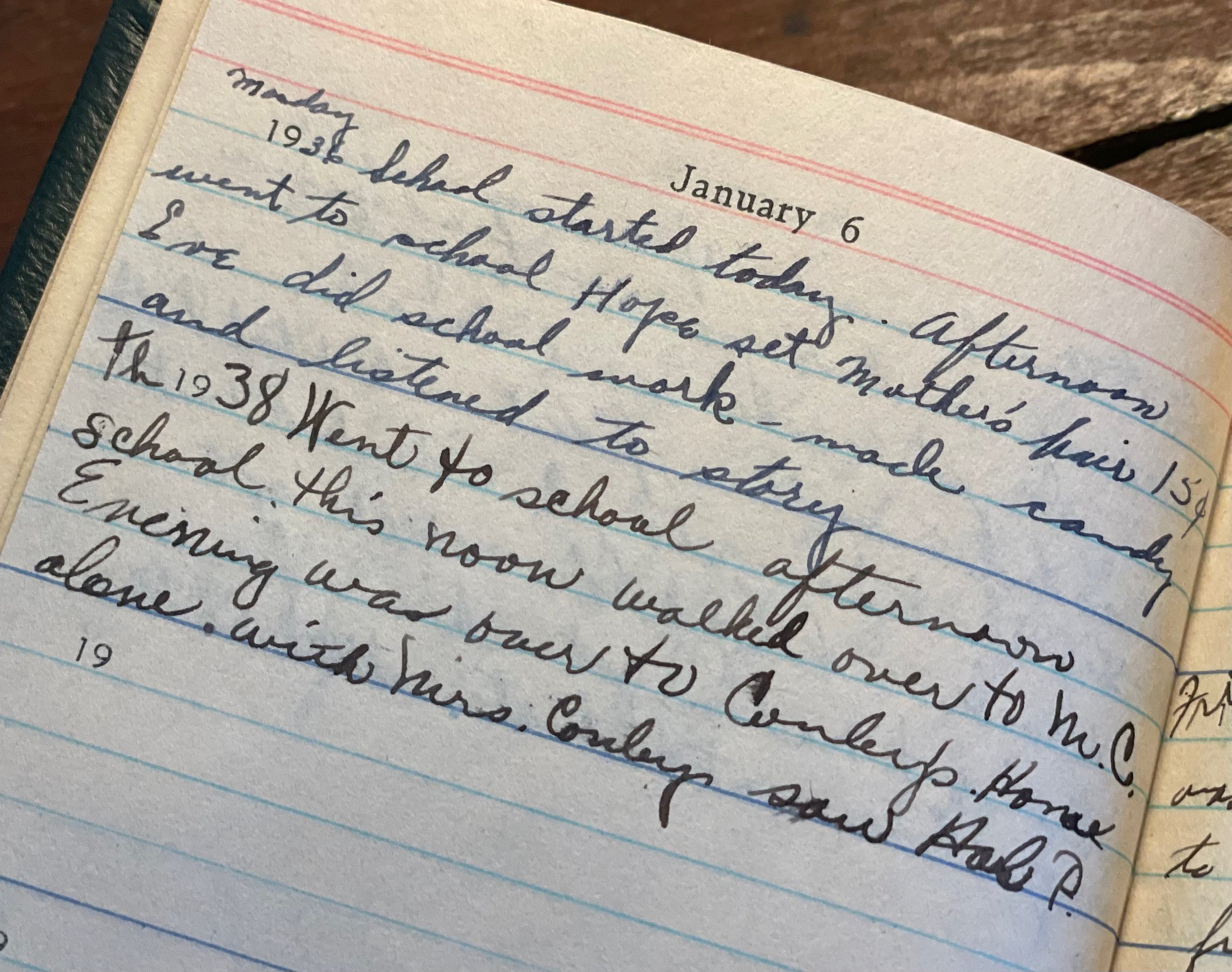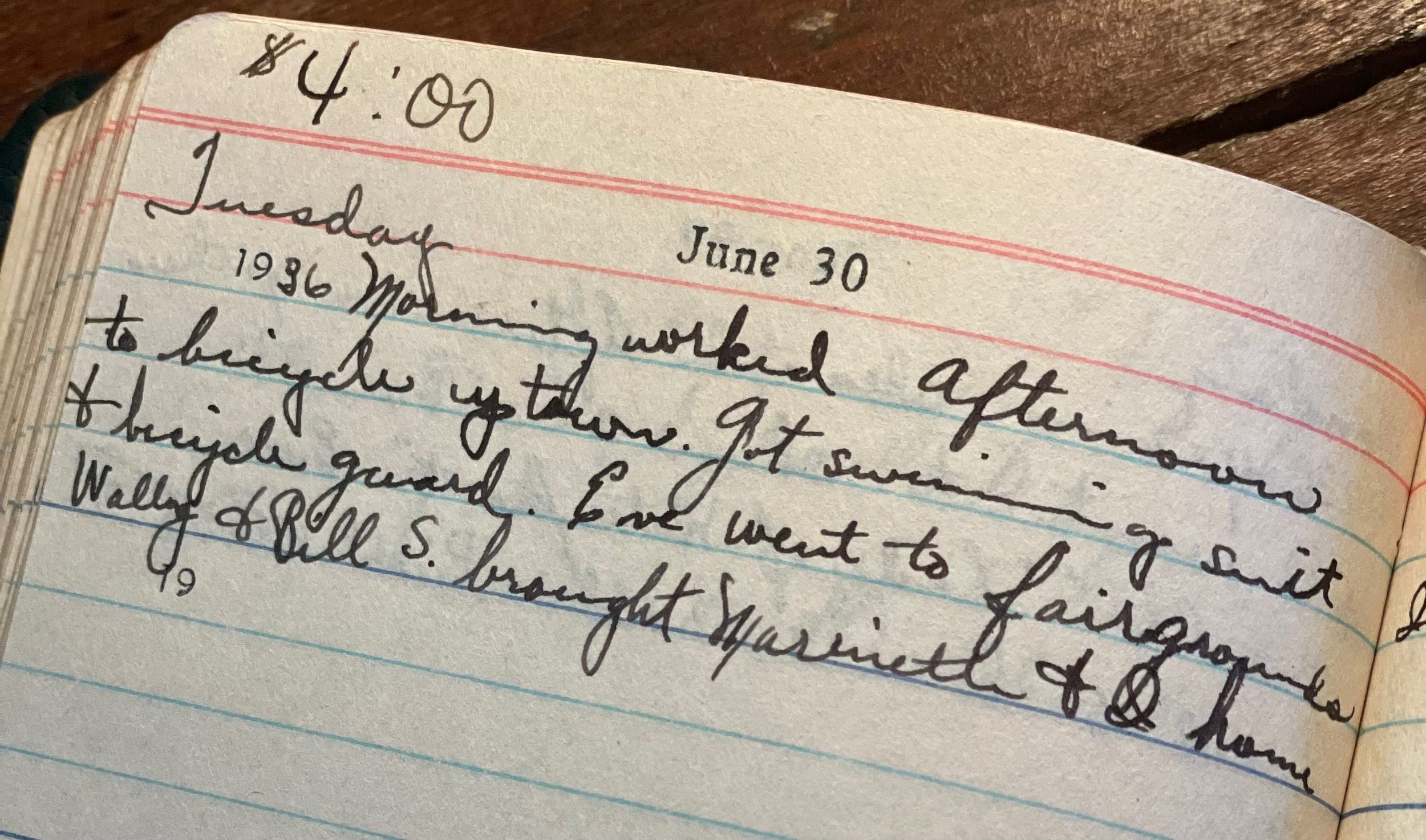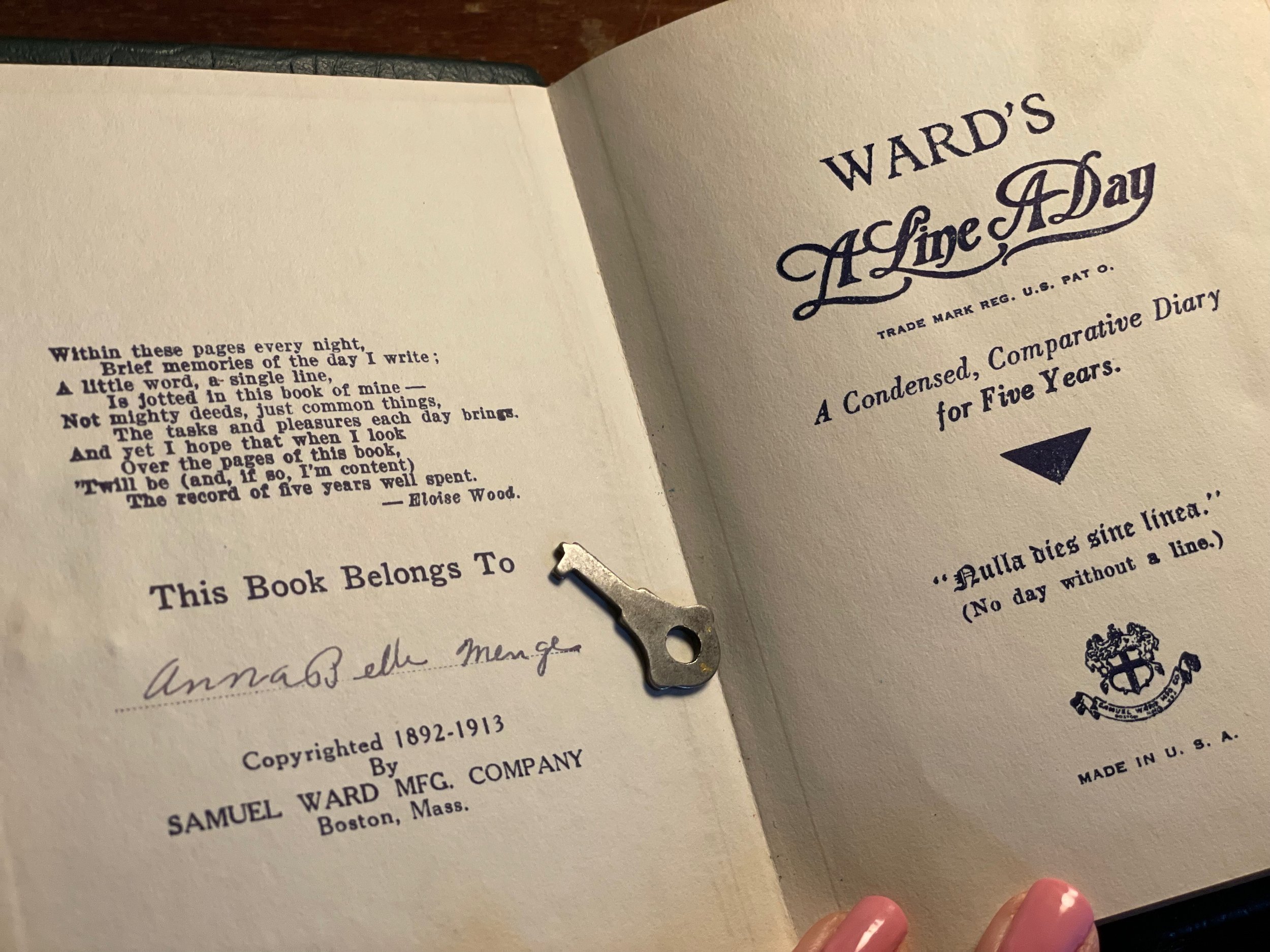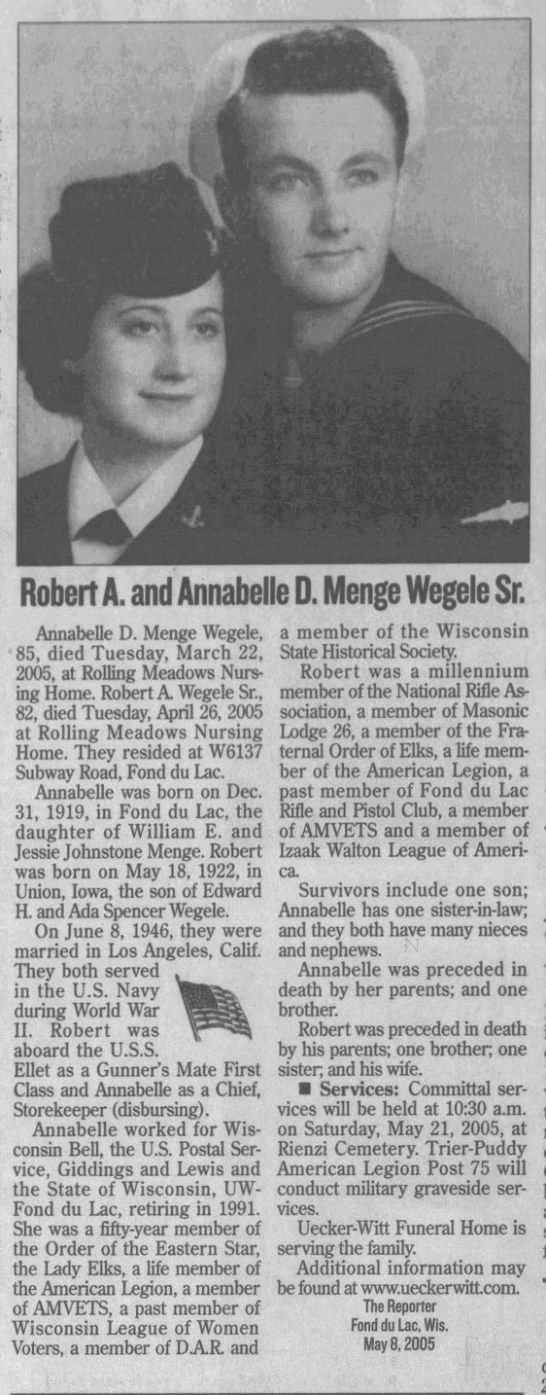Annabelle Menge
Annabelle lived in Fond du Lac, Wisconsin, and was 16 years old when she started her diary in 1936. I also have a diary of hers from 1943 that she wrote in the weeks before she left to serve in the Navy during WWII as a Chief Storekeeper, along with her future husband, Robert Wegele.
Introduction
Annabelle Dorthy Menge was born to William Emil Menge (1888-1975) and Jessie James (Johnstone, 1887-1983) on New Year’s Eve, 1919, in Fond du Lac, Wisconsin. Fond du Lac sits on the southernmost shore of Lake Winnebago, which gave the city its name, meaning “bottom of the lake” in French. Various Indigenous Nations called this area home, including the Winnebago, Potawatomi, Kickapoo, and Mascoutin. It was later colonized by French fur trappers in the early 1800s. In 1835, the construction of the Military Ridge road was started, connecting forts in Wisconsin and Fort Dearborn in Illinois. The first school was built in 1843, the first railroad was built in 1852, and the first English newspaper, the Fond du Lac Commonwealth, was founded in 1856. With the abundant forests and access to the lake, logging and milling were the primary industries throughout the 1880s. In 1936, when we meet Annabelle, the city had about 26,000 residents. Today, it has around 44,000.
Downtown Fond du Lac, 1935
Annabelle’s father, William, was born in Mecan, Wisconsin to German immigrants. He was one of about eleven children; I say “about eleven” because some of his siblings did not live past infancy and their historical records can be difficult to find. In his adulthood, he was a fireman in the 1920s, and then became a diesel engineer for the Soo Line Railroad. He would have this job for 45 years. He married Annabelle’s mother, Jessie, in July 1913. Jessie was one of three girls all born in Wisconsin. After high school, Jessie worked as a hospital attendant for a short time before she married William. In August of 1914, William and Jessie had their first child- Robert John Menge, in Fond du Lac. Not long after, in November of 1915, they had their second child, a daughter named Jennie, but she only lived for three days after she was born. It would be over four years later that Annabelle was born on December 31st, 1919.
I have two of Annabelle’s diaries- one from 1936 and one from 1943. In the first, she is a 16-year-old schoolgirl concerned with all the things you would expect a girl that age to be concerned with including going out with friends, crushes on boys, and grades in school. When we catch up with her in 1943, she is preparing to enlist in the Navy during World War II. The way she writes and the perspectives she shares have, of course, changed since her childhood, and in her second diary, she speaks to us in the voice of a woman embarking on an experience that will change her life forever. Let’s meet Annabelle on January 1st, 1936.
The First Diary
Annabelle received her first diary from her parents as a Christmas present in 1935, and she began writing in it in the New Year. It is a green 5-year diary with a lock and key. Fortunately, it has stayed in its original box and with its original key for all these years! In 1936, Annabelle was living at home with her parents in Fond du Lac and attending high school. Her daily life consisted of visiting with friends, doing school and house work, crushes on boys, and spending time with her family in the evenings around the radio. Each day, she commented on what she did in the morning, afternoon, and evening in her diary.
January 6
Monday
School started today. Afternoon went to school. Hope set Mother’s hair 15c. Eve did school work, made candy and listened to story.
Annabelle also often went to the theater to see shows with her mother and friends, and often commented on each one she saw. If someone out there is interested in the history of movies, I’m sure the titles would make sense to you. They include “Freckles + Beat the Band,” “The Man Who Broke the Bank at Monte Carlo,” and “Tough Guy” with Rin Tin Tin.
January 12
Sunday
Morning read paper. Afternoon went to show and saw “Annapolis Farewell” with Richard Cromwell, Tom Brown, John Howard. Eve the nuts* were here. Did work.
Annabelle was also on the basketball team at her school and seemed to be competitive- she often went to games with her friends and commented about the winning score. At the end of January, she took her “6 week tests,” which I understand to be cumulative exams in each of the subjects she is taking. At the back of the diary, she gave her grades and I have to say, they aren’t impressive (“Economics test 65 Shorthand 53 Latin 69 English 48”)! She did note that she needed to study more in the same entry. At this point in her life, she spent lots of time with her family and friends, took saxophone and tennis lessons, and went to basketball games, so studying doesn’t seem to have been high on her list of priorities. She did remark about doing school work often in her diary, but her New Year's Resolution, written down in the Memoranda section after the month of January, might be telling about her feelings about school.
January 31
Fri
Morning school. Afternoon school. Played basketball beat them 4-1. Eve Fond du Lac played Oshkosh won 27-23 and exciting game. Went to Milt’s afterwards.
Memoranda
Jan 24th game postponed until Feb 11. Postponed again until further notice because of weather.
New Year’s Resolution: Not to be late for school: No necking
Annabelle’s brother, “Bob” as she called him, had moved out of the family’s home by 1936, but was still living in Fond du Lac and making a living as a driver. From his obituary, we know that he also attended Ripon College, so perhaps he was doing both during this time. He did come home occasionally and Annabelle always commented on it happily. She also spent time with her mother often; they went to shows, shopping, and went on day trips to nearby cities such as Oshkosh, Waupun, and Milwaukee. Annabelle occasionally mentioned her father as well; for example, he made repairs to their house and she sometimes stayed up late talking to both her mother and father.
On Tuesday, May 12th, Annabelle mentioned driving the car for the first time and then kept a record in her diary of the number of miles that she has accumulated in the driver’s seat. I remember needing to drive a certain number of miles while supervised before I could take my driving test at 16. I wonder if this was the same for her?
May 12
Tuesday
Morning school. Afternoon school. Eve delivered flowers, saw Bluefinger’s house + V. Rosenthal drove home first time.
By the summer, Annabelle spent time riding her bike, continued tennis lessons, and worked on weekday mornings. I’m not sure what she did for work, but she often mentioned typing and sometimes made a note of how much money she had earned. It must have been somewhere close to her home since she didn’t have her driver’s license yet.
June 30
$4.00
Tuesday
Morning worked. Afternoon to bicycle uptown. Got swimming suit + bicycle guard. Eve went to fairgrounds. Wally + Bill S. brought Marinetta + I home.
On September 29th, Annabelle and her parents moved “to the Lake” and she mentioned having all new classes and traveling to school on the train, which she had not done before. This move and a new school allowed for new crushes and she mentioned some of the boys in her new classes. Still, it seems that she kept up with all her old friends too, and she continued to talk about friends whose names we are familiar with by now- Marietta, Dot, Madey, and the Conley’s.
Like many diary writers, Annabelle lost interest in her diary around October, 1936. This was soon after her move, so perhaps she got wrapped up in her new home and school. Because this was a 5-year diary and had room for entries in subsequent years, Annabell was able to include a few entries from 1938 in this diary as well! Now, she doesn’t use the same “Morning, afternoon, evening” format and writes in longer, more detailed sentences. I think, based on her age, that she would have been entering her final year of high school in 1938. On January 3rd, she mentioned that, “School started again today,” It seems that she was still playing basketball and seeing the same friends as well. There are only entries for a few days in 1938- just from January 1st to the 11th- but it is interesting to get that small glimpse into her life two years after her initial entries. At the very end of the diary, Annabelle included some names and addresses of friends, many of whom she had referenced spending time with in the diary.
Her Story Continues
Between Annabelle’s two diaries, there is a span of about 6 years. During that time, I only have one record of her life- the 1940 Federal Census. In it, she was listed with her parents in Fond du Lac, was 20 years old, and had graduated high school. In 1938, Bob married Lottie Ethel (Martin, 1916-2011) and they were living in Waupun by 1940 according to his World War II draft cards. I don’t think that Bob ever served, however, because he and Lottie had their first child, Annabelle Dorothy named after his sister, in July of 1942 and their second child in July of 1944.
We can pick up with Annabelle again in 1943 as she prepared for her next big adventure- enlisting in the Navy and serving in World War II. I think that she must have started this diary because of this huge event in her life. There are just two entries from January and then it jumps to March. She is pretty faithful in her writing until May 15th, which was just a few days before she left for Navy training. Let’s pick up with her in 1943.
The Second Diary
Annabelle’s second diary is a small pocket-sized book with two days per page. She began writing on January 1st, 1943. On that day, she just mentions when she woke up and that she “puttered around the rest of the afternoon.” In the space for January 2nd, she wrote the names of two books- Valley of Decisions by Margaret Davenport and One World by Wendell Wilkin. Then, the diary skips to March 11th when Annabelle and 7 of her friends enlisted in the WAVES program in the Navy (see below for more information about the WAVES program and the women that served in WWII). On this day, Annabelle noted that she passed her IQ test, but was told that she needed to lose 6 pounds. After that, the diary skips to March 20th for another big event; this is the day that Annabelle was officially sworn into WAVES. She and her friend, Grace, went out for martinis that night to celebrate.
March 20
Lost 8 ½ lbs following Navy Diet. I was sworn in the Waves today. Grace took me to lunch + martinis in Red Room to celebrate.
In the following weeks, Annabelle visited many friends and family and readied herself to go to Navy training. I can feel her excitement in these weeks as she documented her preparations to leave. She visited family including Aunt Clara, Aunt Aggie, and Uncle Louise, and spent a lot of time with friends. Aunt Aggie even got Annabelle an interview in The Star!
April 28 Wed
Today Aunt Clara wrote the Star wants to interview me Sunday. Also has a card from Aunt Clara. Roland Hansen left for Farragut, Idaho today Navy Camp.
April 29 Thurs
Mrs Giese gave a dinner party for me- 8 guests. We played 50 and had a very nice time. Mary Ridgeway Kaiser + I won prizes. I had a beautiful corsage of carnations + red roses. The girls gave me 5.00. I had a marvelous time.
On May 1st, Annabelle got her orders- she was to leave on the 17th from Hunter College, N.Y. and wrote, “Happy Days,” in her diary that day. She seems excited and anxious to leave. On May 2nd, she had a busy day visiting friends and family, but wrote at the end of her entry, “Had a hard time getting to sleep- Waves on mind.”
During these short weeks, Annabelle mentioned other young people that she knew that were already overseas or were preparing to leave to fight in the war. On various days, she wrote, “Roland Hansen left for Farragut, Idaho today Navy Camp,” “Virginia sure misses Kenney. She read a letter from him. He is at Pensacola, Fla.,” and “Jr Northrup is on his way to Norfork, Va to gunnery school.” It’s incredible to think about being one of these young people watching their friends and loved ones leave for war and anticipating the day when they themselves would leave as well. Annabelle is getting into it though; on May 4th, she starts reporting the time in her diary in 24-hour military style.
May 4 Tuesday
Hit the deck at 0800. Had breakfast made a salad + went ashore at 0930. Went out to Uncle Louie + then had lunch at Aunt Clara's. About 1500, I went downtown. Went home at 1600. Made dinner- we all did dishes + I caught the train at 2100. Winnie rode down to the station with me. Arrived home at 2230- bed 2430.
By May 9th, her preparations were getting more serious. She started to pack things that she wouldn’t be taking with her mother, shellacking her name onto her hairbrush and toothbrush, and shopping for things that she would need to take with her. On May 11th, she received her travel orders. After that, she spent time with her parents on a day trip to Princeton, played golf with a friend, visited with more friends, and had her hair done. Her last entry was on May 15th, just two days before she left for WAVES. Even though we don’t learn more about her day-to-day life in the Navy, I do think that she took this diary with her. In the back of the diary in the Memoranda section, there are a few addresses of people that must have been in the Navy as well, both from San Francisco (giving more weight to my suspicion that she must have been posted on the West coast or in Hawaii close to Robert.
After
Annabelle’s decision to serve in the Navy was a brave one and one that was only newly available to women. Prior to the First World War, the only service option for women in the Navy was nursing. Then, in 1916, the US passed Public Law 241 stating that any US citizen could serve in the Navy and this opened other opportunities for women to serve. In WWI, 11,000 women served in the Navy, along with 269 female Marines. After the Pearl Harbor attack, the Navy realized that it wouldn’t be able to meet the demand that the War Manpower Commission set for the number of soldiers needed. The Navy quickly realized that it needed women to join. As pressure mounted, Congress created the Women’s Auxiliary Army Corps (WAAC) in 1942 and, in July of that year, President Franklin Roosevelt signed Public Law 689 to create the Women’s Naval Reserve. Under this law, women did not serve on the front lines; they took over administrative roles, freeing up more men to serve in combat. While WAAC was created as a supplemental branch of the Army, the Women’s Navel Reserve was an integrated part of the Navy.
Still, there were disputes about the circumstances and conditions under which the Navy would allow women to serve. To address these concerns, they formed an Advisory Council made up of women that were not from military backgrounds, but instead ran the best women’s colleges in the country. These women advised the Navy about the best methods to train and recruit women specifically. They also helped design the uniform and come up with an acronym for the name of the unit. This task fell to the second in command, Elizabeth Reynard. She needed to include a “V” for “volunteer” because the Navy wanted to stress that enlistment was voluntary and not drafted service. With the inclusion of a “W” for “women” and a desire to keep to a nautical theme, she decided on “Women Accepted for Volunteer Emergency Serve” or WAVES.
The eligibility requirements to join WAVES were tough. To be eligible for officer candidate school, women needed to be between the ages of 20-40, and have a college degree or two years of college and two years of other professional experience. For volunteer service, women needed to be between 20-35 years of age and have a high school or business diploma and other relevant experience. To find women that met these criteria, the Navy embarked on a recruitment campaign. Propaganda posters were posted on college campuses and recruiters visited campus as well. Posters and presentations often emphasized the equity that they aimed to achieve between enlisted men and the women chosen to join WAVES. Female recruits would earn the same pay, follow the same traditions and rules, and conduct the same non-combat work as their male counterparts. They received a few months of general training and then specialized training on college campuses and naval facilities around the country. Many were trained to do clerical work, but some were trained for roles as radio operators, financial experts, and in chemical warfare and aviation. WAVES made up about 2.5% of the Navy during WWII and were integral to the war effort. After their service, they were able to bring the skills they learned home with them and into their professional lives.
During the war, Annabelle served as a Chief Storekeeper (Disbursing), the highest rank or “First Grade” that a Storekeeper could achieve. Chief Storekeepers were tasked with maintaining a ship or company with military supply stores. Their responsibilities included purchasing and procurement, shipping and receiving, and issuing equipment, tools, and other items obtained through the federal stock system. They could be stationed either on a ship or on shore. Essentially, they were logistics specialists that made sure that the company or ship that they were assigned to had everything that it needed to fight the war. I would love to be able to tell you all the incredible things that Annabelle did to aid the US’s efforts, but I don’t have any more information than her rank. I have put in a request with the National Archives for her military service records, so I will update here with more information if and when I get them.
At some point during the war, Annabelle met the man that would become her future husband- Robert Allen Wegele (1922-2005)! He was born in Union, Iowa to Edward Wegele (1891-1974) and Ada Luella (Spencer, 1898-1988) and was one of four siblings. His family bounced around Iowa for a bit in his early years, moving from Union to Boone (which is where I live now), and landing in Des Moines between 1920 and 1935. In 1940, his family was still in Des Moines, but it won’t be long until WWII called on Robert. He entered into active service on December 17, 1941 and left the United States on January 28, 1942. He served in the Navy on the USS Ellet as a Gunner’s Mate First Class.
Just like Annabelle, I can’t be sure of Robert’s exact activities during the war, but I do know the ship he was assigned to. The USS Ellet was a Benham-class destroyer that fought off air attacks near Guadalcanal, rescued men from the sea after their ship sank, patrolled the Solomon Islands, and ran back and forth from Pearl Harbor for repairs and supplies often. In January 1944, the Ellet screened carriers about to invade the Marshall Islands, saw action in New Guinea, and then joined the 5th Fleet for the invasion of the Mariana Islands. She then joined the Marianas Patrol and Escort Group, bombarded Iwo Jima, and escorted convoys and patrolled air-sea rescues based in Guam and Saipan. Robert returned to the United States on March 6, 1945 and officially separated from active service on December 16, 1946.
Annabelle and Robert were married on June 10th, 1946 in Los Angeles just a few short months after returning from the war. Again, I don’t know if their service locations overlapped, but I do know that Storekeepers served in Hawaii, a place that Robert’s ship would return to often. I think it is interesting that they were married in Los Angeles as well; perhaps they really did meet in the Pacific. By 1950, they were settled in Fond du Lac; she was working for Wisconsin Bell Telephone Company as a Supervising Clerk and he was a Lineman for an electric power company. In January 1962, their only child, Robert A Wegele Jr. was born.
Robert Jr. went to college at North Central College in Illinois and majored in business. He then returned to Fond du Lac to live with his parents. He worked in the oil industry there and remained in this career for the rest of his life. Robert Jr. eventually bought his childhood home from Annabelle and Robert Sr., and built a new one in its place where the three of them lived until Annabelle’s and Robert’s deaths. In the meantime, Annabelle remained close to her parents (see a newspaper clipping from Jessie’s birthday in 1980) and devoted to her husband and son. Robert and Annabelle announced their 50th wedding anniversary in the Fond du Lac newspaper, the Reporter, on June 9th, 1996.
The rest of Annabelle’s family all stayed close in and near Fond du Lac, Wisconsin. Annabelle’s father, William, remained at his job as an engineer until he retired in 1958. He then got to spend his time with his beloved gladiolus in his garden until his death in May, 1975. Annabelle’s mother, Jessie, died in July, 1983. Her brother, Bob, became a special investigator for the Soo Line Railroad, the same company that his father worked for, and he and Lottie had a third child in 1958. Bob retired in 1976 and died right before his mother did in February, 1982.
Annabelle died in Fond du Lac on March 22nd, 2005 and her husband, Robert, followed her just over a month later on April 26th, 2005. Due to the close timing of their deaths and, no doubt, to their love for each other, they shared an obituary on May 8th, 2005 in the same newspaper that had celebrated Jessie’s birthday and their 50th wedding anniversary. They are both buried in the Rienzi Cemetery in Fond du Lac. Tragically, it wasn’t long until Robert Jr. followed them in death as well. He died of COVID-19 at the age of 59 on January 3rd, 2022, living in the same home that he had shared with his parents. His obituary in the Reporter lovingly listed his many friends and even the “adopted brother” and “sister” that he left behind.
It wasn’t long after Robert Jr.’s death that Annabelle’s diaries came to me. Robert Jr. had no direct relatives, having never married or had children, so I wonder if perhaps his possessions and the possessions he kept after Annabelle’s and Robert Sr.’s deaths were sold together. I have found that this isn’t uncommon; I seem to have many diaries that belonged to people with no relatives to inherit them. I’ll happily keep Annabelle’s diaries safe and keep the story of her, her husband, and their family here.
References
For Seniors. (1980, April 28). The Reporter, p. 2.
Robert A. and Annabelle D. Menge Wegele Sr. Obituary. (2005, May 8). The Reporter, p. 2.
Robert A. “Bob” Wegele Jr. Obituary. (2022, January 19). The Reporter, p. A5.
The WAVES of World War II. (2019, September 25). National Women’s History Museum. Accessed at:
https://www.womenshistory.org/exhibits/waves-world-war-ii
Wegele 50th. (1996, June 9). The Reporter, p. 18.
